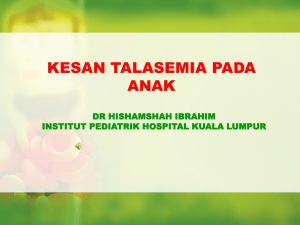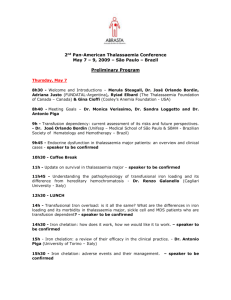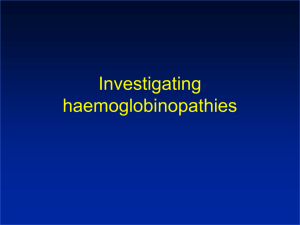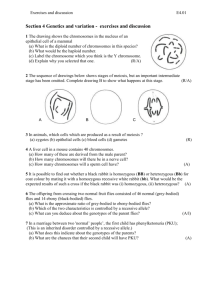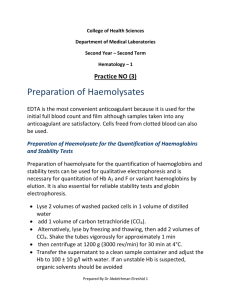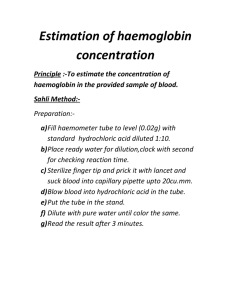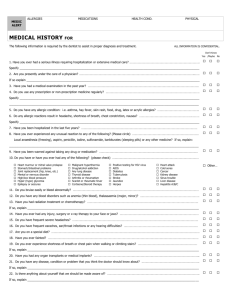The Major and the Minor
advertisement
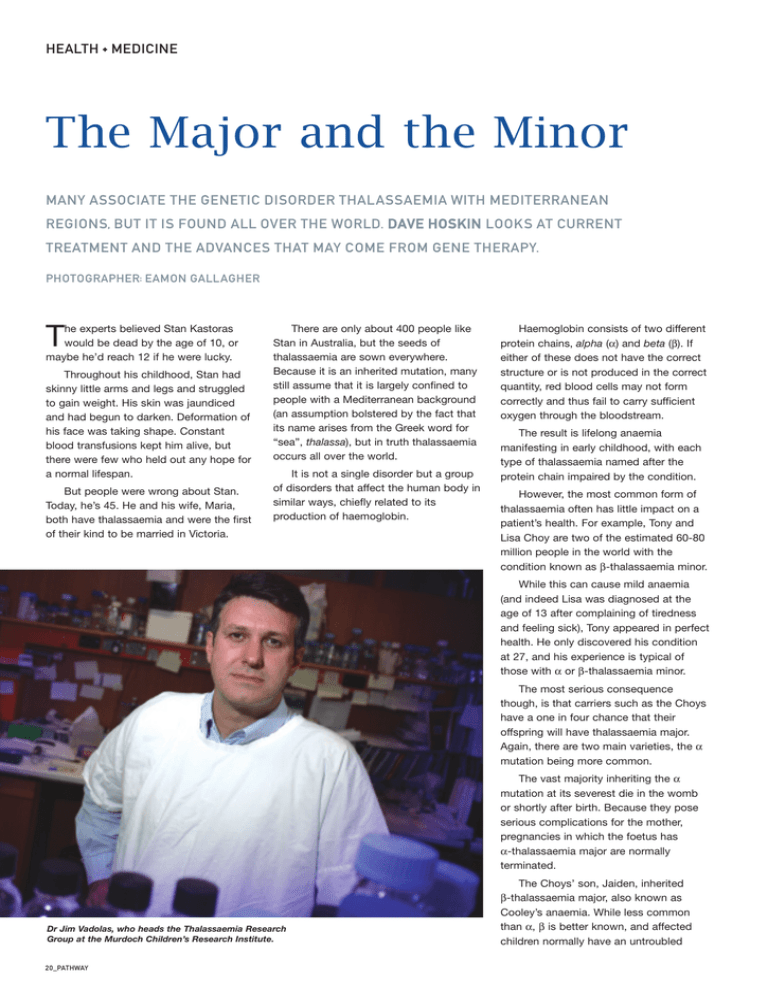
HEALTH + MEDICINE The Major and the Minor MANY ASSOCIATE THE GENETIC DISORDER THALASSAEMIA WITH MEDITERRANEAN REGIONS, BUT IT IS FOUND ALL OVER THE WORLD. DAVE HOSKIN LOOKS AT CURRENT TREATMENT AND THE ADVANCES THAT MAY COME FROM GENE THERAPY. PHOTOGRAPHER: EAMON GALLAGHER he experts believed Stan Kastoras would be dead by the age of 10, or maybe he’d reach 12 if he were lucky. T Throughout his childhood, Stan had skinny little arms and legs and struggled to gain weight. His skin was jaundiced and had begun to darken. Deformation of his face was taking shape. Constant blood transfusions kept him alive, but there were few who held out any hope for a normal lifespan. But people were wrong about Stan. Today, he’s 45. He and his wife, Maria, both have thalassaemia and were the first of their kind to be married in Victoria. There are only about 400 people like Stan in Australia, but the seeds of thalassaemia are sown everywhere. Because it is an inherited mutation, many still assume that it is largely confined to people with a Mediterranean background (an assumption bolstered by the fact that its name arises from the Greek word for “sea”, thalassa), but in truth thalassaemia occurs all over the world. It is not a single disorder but a group of disorders that affect the human body in similar ways, chiefly related to its production of haemoglobin. Haemoglobin consists of two different protein chains, alpha (α) and beta (β). If either of these does not have the correct structure or is not produced in the correct quantity, red blood cells may not form correctly and thus fail to carry sufficient oxygen through the bloodstream. The result is lifelong anaemia manifesting in early childhood, with each type of thalassaemia named after the protein chain impaired by the condition. However, the most common form of thalassaemia often has little impact on a patient’s health. For example, Tony and Lisa Choy are two of the estimated 60-80 million people in the world with the condition known as β-thalassaemia minor. While this can cause mild anaemia (and indeed Lisa was diagnosed at the age of 13 after complaining of tiredness and feeling sick), Tony appeared in perfect health. He only discovered his condition at 27, and his experience is typical of those with α or β-thalassaemia minor. The most serious consequence though, is that carriers such as the Choys have a one in four chance that their offspring will have thalassaemia major. Again, there are two main varieties, the α mutation being more common. The vast majority inheriting the α mutation at its severest die in the womb or shortly after birth. Because they pose serious complications for the mother, pregnancies in which the foetus has α-thalassaemia major are normally terminated. Dr Jim Vadolas, who heads the Thalassaemia Research Group at the Murdoch Children’s Research Institute. 20_PATHWAY The Choys’ son, Jaiden, inherited β-thalassaemia major, also known as Cooley’s anaemia. While less common than α, β is better known, and affected children normally have an untroubled Although Stan and Maria Kastoras both suffer from Thalassaemia, they live a full and happy life. birth. Indeed, in the early part of their lives they may appear perfectly healthy. team determining whether the results indicate the presence of disease. Dr Maxwell says. “The size (or) number of In Jaiden’s case, the diagnosis was confirmed at the age of six months. His parents knew that his condition was a strong possibility (he was only confirmed so late because of an inconclusive amniocentesis), but in other cases, such as that of Maria Kastoras, the parents will notice symptoms that lead them to consult a doctor. “We try and identify, for instance, women of childbearing age who have potential to be carrying genetic abnormalities that may have consequences for them,” explains Dr Ellen Maxwell. the red cells … those are the sort of If a GP suspects thalassaemia, blood samples will be sent for testing. At laboratories such as Melbourne Pathology, the samples are given a full blood examination, with the haematology Every day, Melbourne Pathology’s full blood examinations detect a certain number of films with abnormalities, and these are flagged for more rigorous analysis. “There will be a number of things that you can measure when the blood goes through an automated cell analyser,” the red cells, how much haemoglobin is in things we might look at to try and determine whether or not we think someone’s got a haemoglobinopathy or thalassaemia syndrome.” But haemoglobin problems may not be detected in routine blood analysis and may instead be discovered during other tests. For instance, testing for the stability of diabetes may expose sickle cell trait, one of a number of haemoglobin defects that may not have abnormal red cell signs. PATHWAY_21 The principal treatment is blood transfusions every four to six weeks. But thalassaemia also causes people to absorb iron excessively, and when combined with their frequent transfusions, patients are at risk of a dangerous iron overload. The haematology team may also suggest testing that can clarify the initial diagnosis, and once the specific results are interpreted, they liaise with the doctors requesting the tests. If, for instance, a positive result for β-thalassaemia minor is discovered during pregnancy, usually the next step is to suggest testing for the partner in the relationship. “If it’s clear that it can’t be established whether there’s a problem,” says Dr Maxwell, “or it’s clear that there will be potentially a problem, then we would refer them on.” In Victoria, this referral would be to the Thalassaemia Clinic at Monash Medical Centre. Run by Dr Don Bowden, the clinic provides care and diagnostic services, and is able to arrange DNA testing to clarify whether someone is a carrier, as well as partner and prenatal testing. If a risk of severe disease is discovered, the clinic’s counselling service can discuss prenatal options (or if the patient wishes to have counselling elsewhere, the Mercy and the Royal Women’s hospitals are also available). These choices would cover every possibility for how the pregnancy can proceed, and if an affected child is born, the clinic will be responsible for their treatment. “We work very hard to give people with β-thalassaemia major the best quality of life we can,” says Dr Bowden. “My view is the individual is responsible for their own care and I’m here to advise and to help … (From an early age) we are facilitators of individuals getting and developing an independent life for themselves.” Dr Erica Wood, Transfusion Medicine Specialist for the Australian Red Cross Blood Service in Victoria says "the principle treatment is blood transfusions and some patients will require two to four unit of red blood cells every three to four weeks for many years.” But thalassaemia also causes people to absorb iron excessively, and when combined with their frequent transfusions, patients are at risk of a dangerous iron overload. For example, Stan Kastoras woke up in hospital on Christmas Day 1999, and was told that he had had a heart attack. Maria had found him collapsed in their garage, and kept Stan alive with CPR until the ambulance arrived. The standard chelation therapy to reduce iron levels was only introduced when Stan was 16, and a large amount of iron had already settled in his heart. To avoid this kind of damage, chelation therapy involves an injection of desferrioxamine, which binds to the iron in the body and is then excreted in urine. Most patients use an infusion pump to inject the medicine while they sleep, the process taking 10 to 12 hours every night. While chelation therapy is crucial, the long daily injections are daunting. “The injection pump becomes a pain at times and I hate doing it,” Maria says. She admits that sometimes she doesn’t do it at all. This is a common reaction among people with thalassaemia, and the news that the American Food and Drug Administration has recently approved an oral form of chelation has filled them with excitement. Known as Exjade, the new chelator is a tablet that can be dissolved in water. Thalassaemia is curable, but as this involves a bone marrow transplant, very few patients can find compatible donors. “If it’s not your brother or sister, generally it can’t be done,” says Dr Bowden. “There’s a one in four chance of a sibling being a compatible donor, (but) the number of patients that have sibling donors in this country is very, very small.” Dr Erica Wood, Transfusion Medicine Specialist for the Australian Red Cros Blood Service in Victoria 22_PATHWAY Dr Jim Vadolas, who heads the Thalassaemia Research Group at the Murdoch Children’s Research Institute, hopes to find a more viable alternative. The group is pursuing at least three kinds of therapy for thalassaemia, with one of Dr Don Bowden of the Thalassaemia Clinic at Monash Medical Centre. the most promising involving its research into foetal haemoglobin. “We all express foetal haemoglobin in our lifetime,” says Dr Vadolas. “But just after we’re born, it switches off.” It has been discovered that some patients have a mutation that causes elevated levels of foetal haemoglobin throughout their lives, complementing the defect in the β-globin. “If we can switch on the foetal haemoglobin gene, or upregulate foetal haemoglobin,” Dr Vadolas says, “we have a means of therapy.” The challenge then becomes discovering a trigger, but without a clear understanding of the underlying mechanisms it is virtually impossible to focus on any molecular target. “It’s literally a fishing expedition,” says Dr Vadolas. “We’ve created what we feel is one of the best in vitro model systems, and we’re collaborating with people at (the Walter and Eliza Hall Institute of Medical Research in Melbourne) to identify novel molecular compounds that increase the expression of foetal haemoglobin. They have what we call a high-throughput chemical screening facility.” The institute has a chemical library of 100,000 compounds, and Dr Vadolas hopes that some of those will be found to trigger foetal haemoglobin. First though, the group must concentrate on the institute’s library of FDA-approved drugs. “We’ve had our first screen with this library of 2,000 compounds,” Dr Vadolas says. “And we’ve had a few events … which look promising in upregulating foetal globin.” normal messenger RNA is produced, and thus a much lower amount of β-globin. To combat this, antisense molecules are designed to bind to aberrant splice sites and will hopefully encourage more splicing to follow the normal pattern. A third strategy involves delivering large pieces of DNA into haemopoietic stem cells, which give rise to blood cells. “If we can get the stem cells from a patient and introduce a normal gene, then we’re talking about a possible gene therapy,” Dr Vadolas says. Lentiviral vectors, a type of retrovirus that can deliver a significant amount of genetic information into a host cell, have been used in gene therapy research, and there is talk of clinical trials using these to carry the normal β-globin gene. Another approach is antisense therapy, in which what are known as antisense molecules are designed for a particular thalassaemia mutation common in Greece, Cyprus and the Mediterranean region. Known as the IVS1-110 mutation, it interferes in the normal messenger RNA splicing process by forming an aberrant new splice site. One problem with using viruses as delivery mechanisms is their limited capacity for inserted foreign DNA. The research group is trying to work with bacterial artificial chromosomes (BAC) as delivery mechanisms because they can hold much larger fragments of DNA. This enables the inserted piece of DNA to contain all the essential information that controls the level of expression of the gene. It hasn’t entirely been plain sailing, however. Because of these competing normal and aberrant sites, only about 10 per cent “We’re faced with a number of problems working with BACs,” Dr Vadolas concedes. “Predominantly with delivery. But Sara Howden, our PhD student, has got some promising results (for improving) the delivery of these BACs into stem cells.” Whatever the future may hold, people like Maria, Stan and Jaiden are living proof that thalassaemia is no impediment to a full and happy life. The Choys talk proudly about Jaiden matching his friends’ energy levels, eagerly tackling tennis, tae kwon do and swimming. “The difference is psychological,” says Tony. “From day one, we’ve treated him as if he were no different. We’ve always encouraged him and given him all our love. I think that’s the difference.” Likewise, Maria remembers her parents urging her to get out of the house and live the parts of life that others take for granted. There have been struggles along the way, but she and her husband have led full lives including going to school, steady employment and childrearing. “The only thing I want in life,” Stan says firmly, “I’m going to fight whatever I’ve got and whatever I get thrown, just to see my kid grow up, become a man. If he gets married and has a kid, it will be a bonus for me. But that’s all I want.” GPs NOTE: This article is available for patients at http://pathway.rcpa.edu.au PATHWAY_23
